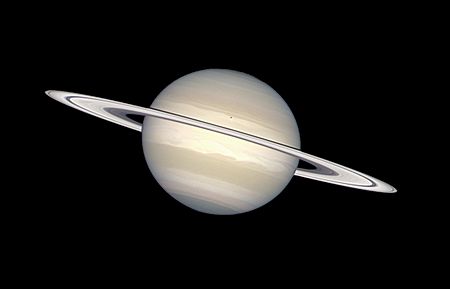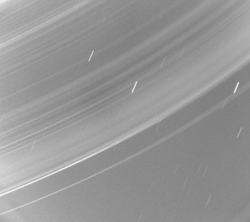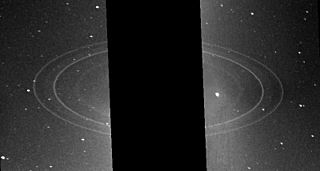Ring system facts for kids
A ring system is a ring made of dust and other tiny pieces orbiting around a planet. It forms a flat, disc-shaped area. The gas giants Jupiter, Saturn, Uranus, and Neptune are the only planets known to have rings. The rings of Saturn are the most amazing ones.
Sometimes, rings have "shepherd moons." These small moons orbit either in between gaps in the rings or along the outside edge of a ring. The moons' gravity helps keep the rings in their current shape with a clear edge. Any material that drifts too close to a moon's orbit can either move back into the ring, float out into space, or stick onto the moon's surface.
The rings can be made of silica (like sand) or water ice. Scientists don't know exactly how any of the rings were formed. They are usually found inside the Roche limit. This is a special distance from a planet where large moons cannot form because the planet's gravity would pull them apart.
Contents
How Planetary Rings Form
Scientists have a few ideas about how thicker planetary rings (the rings around planets) might have formed:
- From material left over from the early solar system. This material was too close to the planet (inside the Roche limit) to come together and form moons.
- From the pieces of a moon that was broken apart by a huge impact.
- From the pieces of a moon that was torn apart by strong pulling forces (called tidal stress) when it passed too close to the planet.
Most rings were once thought to be temporary, disappearing after tens or hundreds of millions of years. However, it now seems that Saturn's rings might be very old, possibly dating back to the beginning of the Solar System.
Fainter rings can form when meteoroids crash into moons orbiting the planet. For example, Saturn's E-ring was formed from material shot out from ice volcanoes on its moon Enceladus.
The tiny pieces that make up rings can be different things. They might be silicate (rocky) or icy dust. Larger rocks and boulders can also be present. In 2007, scientists even found eight tiny "moonlets," only a few hundred meters across, within Saturn's rings. These moonlets create small tidal effects.
Sometimes, rings have "shepherd" moons. These are small moons that orbit near the inner or outer edges of rings, or even within gaps in the rings. The gravity of shepherd moons helps keep the ring's edge sharp and clear. Material that drifts too close to a shepherd moon's orbit is either pushed back into the ring, thrown out of the system, or added onto the moon itself.
Scientists also predict that Phobos, a moon of Mars, will break apart and form a planetary ring in about 50 million years. Its orbit is very low and is getting closer to Mars because of gravity slowing it down.
Jupiter's Rings
Jupiter's ring system was the third to be found. The Voyager 1 probe first saw it in 1979. The Galileo orbiter studied it more closely in the 1990s. Jupiter's rings have four main parts:
- A faint, thick ring called the "halo."
- A thin, brighter main ring.
- Two wide, faint "gossamer rings."
This system is mostly made of dust.
Saturn's Rings
Saturn's rings are the biggest and most impressive ring system of any planet in our Solar System. Because of this, people have known about them for a long time. Galileo Galilei first saw them in 1610, but he didn't realize they were a flat disc around Saturn. Christiaan Huygens correctly described them in 1655.
The NASA/ESA/ASI Cassini mission helped us understand a lot more about how these rings formed and how they move. The rings are not just many tiny ringlets, as some people used to think. Instead, they are more like a single disc with areas of different densities. They are mostly made of water ice with tiny bits of rock. The particles range in size from tiny dust to big rocks.
Uranus's Rings
Uranus's ring system is somewhere between Saturn's huge system and the simpler rings of Jupiter and Neptune. James L. Elliot, Edward W. Dunham, and Jessica Mink discovered them in 1977. Between then and 2005, observations from Voyager 2 and the Hubble Space Telescope found a total of 13 different rings. Most of these rings are dark and not see-through, and they are only a few kilometers wide.
These rings are dark and likely made of water ice and some dark, carbon-rich stuff changed by radiation. There isn't much dust in Uranus's rings. This is because of drag from the planet's thin outer atmosphere.
Neptune's Rings
Neptune's ring system has five main rings. At their densest, they are similar to the less dense parts of Saturn's rings. However, they are faint and dusty, much more like Jupiter's rings. The very dark material in these rings is probably dark, carbon-rich stuff changed by radiation, similar to Uranus's rings. About 20 to 70 percent of Neptune's rings are dust, which is a lot.
Scientists had hints of these rings for decades before Voyager 2 finally confirmed their discovery in 1989.
Visual Comparison
See also
 In Spanish: Anillo planetario para niños
In Spanish: Anillo planetario para niños







